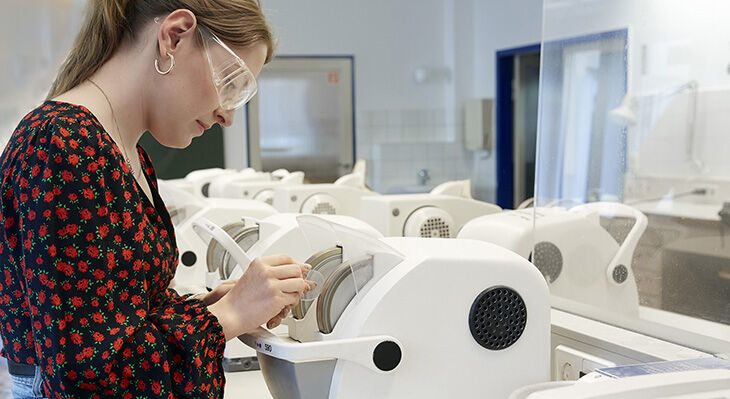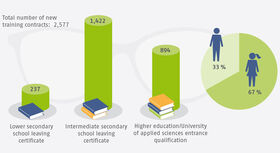Profile of an occupation – optician
Optician is a training occupation for people who enjoy advising customers, appreciate highly precise work and would like to use technical skills. This description of an occupation explores the most important tasks and why the employment opportunities for trained opticians are so good.

Customer services in conjunction with high-tech craft trade skills
The training occupation of optician offers a multitude of tasks connected with customer services, fashion advice, skilled craftsmanship and dealing with high-tech devices. Opticians mainly work at specialist opticians’ shops.
Customer services: Customer advisory services are complex because a pair of glasses is also a medical product rather than merely a fashion accessory. Opticians do everything from identifying customers’ corrective requirements with regard to their eyesight to carrying out the anatomical and optical adjustment of visual aids. They also give guidance on the benefits and drawbacks of contact lenses and instruct customers on their proper usage and care.
Styling expertise: Over half of those who wear glasses do so every day. It is important that the selected model is a good match for someone’s type and personality. Skin and hair colour, style of clothing and occupation are all factors taken into account. For this reason, opticians keep up to date with current developments in eyewear fashion and follow the latest fashion trends. Both specialist ophthalmic journals and fashion magazines help them in this respect.
Precision craftsmanship: The identification and manual processing of the optimum corrective lenses and anatomical and optical adjustment of glasses takes place with the assistance of modern measuring instruments and high-tech equipment. Opticians use special machines to insert the lenses into spectacle frames. These enable the lenses to be exactly centred and positioned within the rim. A good eye and considerable dexterity are needed to perform such a precision task. Alongside manual skills, high-tech devices are deployed for all jobs at hand, including repairs, in order to support the various work processes.
High proportion of training entrants in possession of a higher education entrance qualification

Most young people opting for the training occupation of optician have reached an extremely good level of general schooling. Over half (55%) have achieved an intermediate secondary school leaving certificate, and 35 percent hold a higher education entrance qualification. Women make up 67 percent of trainees (cf. Figure).
Average training allowance per month ranges from €740 in the first year of training to €863 in the third year. A detailed overview by federal state is available on the website www.be-optician.de.
Good prospects for specialist opticians’ stores
41.1 million adults (aged over 16) in Germany wear glasses. 23.4 million of these do so all the time while a further 17.7 million are occasional wearers. This represents a proportion of over 66 percent. Visual aids are difficult to source online because of their particular technical characteristics. There is thus a continuing demand for the country’s 11,100 specialist opticians’ shops. A look at the number of pairs of glasses sold in 2022 make this abundantly clear. 11.2 million pairs of glasses were produced in bricks and mortar stores. By way of contrast, just 260,000 pairs were supplied by retailers with an Internet presence only. This shows that online opticians tend to be supplemental to the overall trade.
Special term: Binocular vision
Binocular vision is a type of vision in which sensory and motor coordination of the left and right eye permit three-dimensional perception. Vision using only one eye is referred to as monovision or monocular vision.
What possibilities are available after training?
Many companies are seeking skilled workers, and employment prospects are very good. An online survey conducted by the German Association of Ophthalmic Opticians and Optometrists in January/February 2023 indicated that 42 percent of companies had attempted to recruit specialist staff during the preceding six months. 68 percent of vacancies remained unfilled, and compromises regarding required qualifications had to be made in 19 percent of cases. The high standard of optician training in Germany means that qualified workers also enjoy outstanding opportunities on the European labour market.
Ophthalmic optics is a licensed craft trade. Those wishing to enter self-employment must therefore pass the master craftsperson examination.
At a glance
- Last updated: 2011
- Duration of training: 3 years
- Responsibility: Trade and industry
- Training structure: Mono-occupation
- DQR reference level: 4
- Advanced vocational training: Master optician or e.g. Bachelor of Science in Optometry
Further information
Occupational information from BIBB: www.bibb.de/dienst/berufesuche/de/index_berufesuche.php/profile/apprenticeship/180111
Occupational information from the sector: www.be-optician.de
“Structuring Training” series of publications: www.bibb.de/dienst/publikationen/de/6717
Podcast on the profile of the occupation featuring two trainees: www.bwp-zeitschrift.de/p181156 (in German)
(All links: status 23/11/2023)
Sources: German Association of Ophthalmic Opticians and Optometrists; Glasses Study 2019, Institut für Demoskopie, Allensbach; BIBB “Training allowances based on collective wage agreements” database 2022
(Compiled by Arne Schambeck)
Translation from the German original (published in BWP 4/2023): Martin Kelsey, GlobalSprachTeam, Berlin